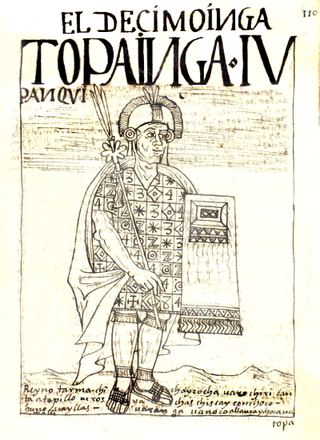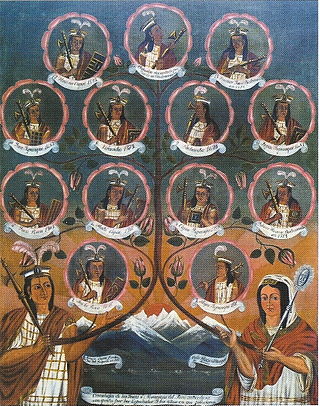Related Research Articles

Pachacuti Inca Yupanqui, also called Pachacutec, was the ninth Sapa Inca of the Kingdom of Cusco which he transformed into the Inca Empire. Most archaeologists now believe that the famous Inca site of Machu Picchu was built as an estate for Pachacuti.

Atahualpa, also Atawallpa (Quechua), Atabalica, Atahuallpa, Atabalipa, was the last effective Incan emperor before his capture and execution during the Spanish conquest.

Huayna Capac was the third Sapa Inca of Tawantinsuyu, the Inca Empire. He was the son of and successor to Túpac Inca Yupanqui., the sixth Sapa Inca of the Hanan dynasty, and eleventh of the Inca civilization. He was born in Tumipampa and tutored to become Sapa Inca from a young age.

Sinchi Roca, Sinchi Rocca, Cinchi Roca, Sinchi Ruq'a or Sinchi Ruq'a Inka was the second Sapa Inca of the Kingdom of Cusco and a member of the Hurin dynasty.

Manco Inca Yupanqui was the founder and monarch of the independent Neo-Inca State in Vilcabamba, although he was originally a puppet Inca Emperor installed by the Spaniards. He was also known as "Manco II" and "Manco Cápac II". He was one of the sons of Huayna Capac and a younger brother of Huascar.

Topa Inca Yupanqui or Túpac Inca Yupanqui, translated as "noble Inca accountant," was the tenth Sapa Inca (1471–93) of the Inca Empire, fifth of the Hanan dynasty. His father was Pachacuti, and his son was Huayna Capac. Topa Inca belonged to the Qhapaq panaca. His qoya was his older sister, Mama Ocllo.

The Sapa Inca was the monarch of the Inca Empire (Tawantinsuyu), as well as ruler of the earlier Kingdom of Cusco and the later Neo-Inca State. While the origins of the position are mythical and originate from the legendary foundation of the city of Cusco, it seems to have come into being historically around 1100 AD. Although the Inca believed the Sapa to be the son of Inti and often referred to him as Intip Churin or 'Son of the Sun,' the position eventually became hereditary, with son succeeding father. The principal wife of the Inca was known as the Coya or Qoya. The Sapa Inca was at the top of the social hierarchy, and played a dominant role in the political and spiritual realm.

A chasqui was a messenger of the Inca empire. Agile, highly trained and physically fit, they were in charge of carrying messages –in the form of quipus or oral information– and small packets. Along the Inca road system there were relay stations called chaskiwasi, placed at about 2.5 kilometres (1.6 mi) from each other, where the chasqui switched, exchanging their message(s) with the fresh messenger. The chasqui system could be able to deliver a message or a gift along a distance of up to 300 kilometres (190 mi) per day.

Among the Inca, a panaka, panaqa or panaca was a family formed by all the descendants of a monarch, a Sapan Inka, excluding from it the son who would succeed in his reign. The basic social institution of the Incas is the ayllu. An ayllu is a group of families that descended from a common ancestor, united by culture and religion, in addition to the agricultural work, livestock and fishing of the same territory. Ayllu concept transcended into nobility, so that the royal kinship could establish a lineage, called panaka or royal house.

Cápac Yupanqui was the fifth Sapa Inca of the Kingdom of Cusco and the last of the Hurin dynasty.

Viracocha or Wiraqucha was the eighth Sapa Inca of the Kingdom of Cusco and the third of the Hanan dynasty.

The Incas were most notable for establishing the Inca Empire which was centered in modern day South America in Peru and Chile. It was about 2,500 miles from the northern to southern tip. The Inca Empire lasted from 1438 to 1533. It was the largest Empire in America throughout the Pre-Columbian era. At the peak of the Inca Empire, it was the largest nation in the world and to this day is the largest native state in the western hemisphere. The Inca civilization was located from north to south of the western hemisphere of South America. The Inca state was known as the Kingdom of Cuzco before 1438. Over the course of the Inca Empire, the Inca used conquest and peaceful assimilation to incorporate the territory of modern-day Peru, followed by a large portion of western South America, into their empire, centered on the Andean mountain range. However, shortly after the Inca Civil War, the last Sapa Inca (emperor) of the Inca Empire was captured and killed on the orders of the conquistador Francisco Pizarro, marking the beginning of Spanish rule. The remnants of the empire retreated to the remote jungles of Vilcabamba and established the small Neo-Inca State, which was conquered by the Spanish in 1572.

The Inca Civil War, also known as the Inca Dynastic War, the Inca War of Succession, or, sometimes, the War of the Two Brothers, was fought between half-brothers Huáscar and Atahualpa, sons of Huayna Capac, over succession to the throne of the Inca Empire. The war followed Huayna Capac's death.
The Chanka people are a Quechua people ethnic group living in the regions of Apurímac, Ayacucho and Lamas of Peru. They were enemies of the Incas, and they were centered primarily in Andahuaylas, located in the modern-day region of Apurímac. The Chankas were divided into three groups: the Hanan Chankas, or the Upper Chankas, the Urin Chankas, or the Lower Chankas, and the Villca, or Hancohuallos. The Hanan Chankas had their center in Andahuaylas, the Urin Chankas in Uranmarca, and the Villca in Vilcas Huaman, Ayacucho.

The Kingdom of Cusco, also called the Cusco confederation, was a small kingdom based in the Andean city of Cusco that began as a small city-state founded by the Incas around the start of 13th century. In time, through warfare or peaceful assimilation, it began to grow and was succeeded by the Inca Empire (1438–1533).
The Coya Mama Ocllo Coya or only Mama Ocllo, was a princess and queen consort, Coya, of the Inca Empire by marriage to her younger brother, the Sapa Inca Topa Inca Yupanqui.
Cuxirimay Ocllo, also known as Doña Angelina Yupanqui, was a princess and consort of the Inca Empire by marriage to her cousin, the Sapa Inca Atahualpa.
Capac Yupanqui, was the brother of the Inca emperor Pachacuti and an Inca general.

Amaru Topa Inca, also known as Amaru Inca Yupanqui, was an Inca prince and co-ruler of the Hanan dynasty, who reigned around 1450. He was the son of Pachacuti and Mama Anawarki. Around 1450, Pachacuti decided to name him his co-ruler and successor. His reign lasted between five and ten years.
References
- ↑ Hernández Astete, Francisco (212). La sucesión entre los Incas - Chungará, Revista de Antropología Chilena - Vol. 44 - (4) pages 655-667 -Arica
- 1 2 3 Comisión de la Academia Mayor de la lengua quechua (2005). Diccionario quechua - español - quechua - Gobierno Regional Cusco - Cusco – Second edition
- ↑ sapan in Quechua means "unique", "the only one"
- ↑ Sarmiento de Gamboa, Pedro (2015 [1575}). History of the Incas, Lexington, ISBN 9781463688653
- ↑ Nair, Stella (2021). At Home with the Sapa Inca: Architecture, Space, and Legacy at Chinchero, New York, USA: University of Texas Press
- ↑ Betanzos, Juan de (2004[1551]). Suma y narración de los incas - edited by María del Carmen Martín Rubio - Ediciones Polifemo - Madrid, 2004 ISBN 84-86547-71-7
- 1 2 3 4 5 Rostworowski, María (2001 [1953]). Pachacutec Inca Yupanqui - Obras Completas I - Serie: Historia Andina, 23 - IEP Instituto de Estudios Peruanos
- 1 2 Hernández Astete, Francisco (2008), "Las panacas y el poder en el Tahuantinsuyo", Bulletin de l'Institut français d'études andines (in Spanish), 37 (1): 29–45, doi: 10.4000/bifea.3282 , ISSN 0303-7495